Indian Institute of Technology, Delhi
(→2016- 23) |
(→2016- 23) |
||
| Line 218: | Line 218: | ||
[https://epaper.timesgroup.com/article-share?article=17_03_2023_009_007_cap_TOI Shinjini Ghosh, March 17, 2023: ''The Times of India''] | [https://epaper.timesgroup.com/article-share?article=17_03_2023_009_007_cap_TOI Shinjini Ghosh, March 17, 2023: ''The Times of India''] | ||
| − | [[File: Vacancies under the SC | + | [[File: Vacancies under the SC, ST seats category at the Indian Institute of Technology Delhi, 2016- 23.jpg|Vacancies under the SC\ ST seats category at the Indian Institute of Technology Delhi, 2016- 23 <br/> From: [https://epaper.timesgroup.com/article-share?article=17_03_2023_009_007_cap_TOI Shinjini Ghosh, March 17, 2023: ''The Times of India'']|frame|500px]] |
| Line 252: | Line 252: | ||
INDIAN INSTITUTE OF TECHNOLOGY, DELHI]] | INDIAN INSTITUTE OF TECHNOLOGY, DELHI]] | ||
[[Category:Pages with broken file links|INDIAN INSTITUTE OF TECHNOLOGY, DELHIINDIAN INSTITUTE OF TECHNOLOGY, DELHIINDIAN INSTITUTE OF TECHNOLOGY, DELHIINDIAN INSTITUTE OF TECHNOLOGY, DELHI | [[Category:Pages with broken file links|INDIAN INSTITUTE OF TECHNOLOGY, DELHIINDIAN INSTITUTE OF TECHNOLOGY, DELHIINDIAN INSTITUTE OF TECHNOLOGY, DELHIINDIAN INSTITUTE OF TECHNOLOGY, DELHI | ||
| + | INDIAN INSTITUTE OF TECHNOLOGY, DELHI]] | ||
| + | |||
| + | [[Category:Education|T INDIAN INSTITUTE OF TECHNOLOGY, DELHIINDIAN INSTITUTE OF TECHNOLOGY, DELHIINDIAN INSTITUTE OF TECHNOLOGY, DELHIINDIAN INSTITUTE OF TECHNOLOGY, DELHIINDIAN INSTITUTE OF TECHNOLOGY, DELHIINDIAN INSTITUTE OF TECHNOLOGY, DELHI | ||
| + | INDIA]] | ||
| + | [[Category:India|T INDIAN INSTITUTE OF TECHNOLOGY, DELHIINDIAN INSTITUTE OF TECHNOLOGY, DELHIINDIAN INSTITUTE OF TECHNOLOGY, DELHIINDIAN INSTITUTE OF TECHNOLOGY, DELHIINDIAN INSTITUTE OF TECHNOLOGY, DELHIINDIAN INSTITUTE OF TECHNOLOGY, DELHI | ||
| + | INDIA]] | ||
| + | [[Category:Pages with broken file links|INDIAN INSTITUTE OF TECHNOLOGY, DELHIINDIAN INSTITUTE OF TECHNOLOGY, DELHIINDIAN INSTITUTE OF TECHNOLOGY, DELHIINDIAN INSTITUTE OF TECHNOLOGY, DELHIINDIAN INSTITUTE OF TECHNOLOGY, DELHI | ||
INDIAN INSTITUTE OF TECHNOLOGY, DELHI]] | INDIAN INSTITUTE OF TECHNOLOGY, DELHI]] | ||
Latest revision as of 10:33, 20 March 2023
This is a collection of articles archived for the excellence of their content. |
Contents
|
[edit] 2016, rankings
[edit] National Institutional Ranking Framework (NIRF): ranked No. 4
The Times of India, April 14, 2016
The rankings under the National Institutional Ranking Framework (NIRF) have been carried out in four categories: Engineering, management, pharmacy and university.
There were five key parameters on which an academic institutes were assessed, these include: Teaching, learning and resources; Research, consulting and collaborative performance; Graduation outcome; Outreach and inclusivity; and Perception.
Over 3,500 institutes participated in inaugural edition of these rankings, the process for which started in December 2015.
With a weightage of 82.03, IIT Delhi is fourth on the premier list. It was established in the year 1961.
[edit] Research & Development
[edit] ACs turned into air purifiers/2019
Ritam Halder, June 4, 2019: The Times of India
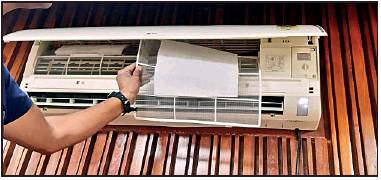
From: Ritam Halder, June 4, 2019: The Times of India
A startup floated by IIT Delhi alumni in collaboration with professors of the institute launched a fix for indoor air pollution. Called Nanoclean AC filters, the innovators claimed these would “turn an AC into an air purifier”.
“We spend most of our time indoors. With our technology, ACs can act like air purifiers without affecting power consumption or performance. Nanoclean AC filters can purify a room up to 90% in just 1 hour of its functioning in an AC without putting additional load on it. This is a ‘do it yourself’ product and can easily be placed in a split as well as window AC. This can be purchased from the company’s website nasofilters.com, Amazon and Apollo Pharmacy stores,” said Prateek Sharma, a co-founder.
According to the other cofounders, Tushar Vyas and Jatin Kewlani, it is a specially designed non-woven structure that can retain pollutants (PM2.5) because of its high dust holding capacity.
“AC filters are much smaller than those used in room air purifiers. Also, unlike cartridges used in air purifiers which have many components, Nanoclean AC filters are made of pure polypropylene that can be recycled into other products. These can be melted and reconverted to other products. So, this is an environmentally friendly technology compared to other marketed products,” Vyas said.
“Inadequate ventilation can increase indoor pollutant levels by not bringing in enough outdoor air to dilute emissions from indoor sources and by not carrying indoor air pollutants out of home. High temperature and humidity levels can also increase concentrations of some pollutants,” Kewlani said, adding that by breathing clean healthier air inside, one can reduce the daily average exposure level.
[edit] Chemotherapy applications/ 2022
January 17, 2022: The Times of India
NEW DELHI: Researchers from Indian Institute of Technology (IIT) Delhi have developed a technology for chemotherapy applications using the red blood cell membrane, which will help in personalised therapy and also reduce side-effects.
According to senior officials of the institute, the technology involves engineering the RBCs in the lab to produce smaller biocompatible vesicles. "Drug molecules can simply be trapped inside the particle's lipid bilayer and circulate for a longer time. At present, few synthetic nanoparticles being used in nanomedicine suffer from short circulation times and are often associated with non-specific toxicity," they said.
The research work by professor Neetu Singh and Sahil Malhotra from IIT Delhi's Centre for Biomedical Engineering utilises the long circulating nature of the RBCs to address a long standing problem of drug delivery, of substantially prolonged drug circulation by delaying the recognition by immune cells.
Delving further into the research, Singh said, "The concept here utilises body's own cells to load multiple drugs at the same time and reach the tumour sites in significant concentrations. Interestingly, this nano-RBCs platform has synthetic tenability similar to other polymeric systems or the commonly used liposomes but have proved to be more efficacious."
Singh further explained, "We were intrigued by nature's own oxygen delivery vehicle, the RBCs, as these are also the longest circulating cells. However, achieving complete control over the physical and chemical properties of a natural system similar to the way we can control a synthetic system is challenging. Over the last few years, we have successfully demonstrated the utilisation of RBCs for drug delivery and developed strategies where the naturally derived vesicles can be tuned for various applications.”
[edit] Hydro fuel: cleaner, cheaper/ 2021
February 8, 2021: The Times of India
From the house of IIT-D, cleaner and cheaper hydro fuel
New Delhi:
Researchers at IIT Delhi have generated clean hydrogen fuel from water at low cost. A steep rise in global energy demand and the necessity to curb greenhouse gas emissions have driven the researchers to look for cleaner and greener energy sources as alternatives.
The study, which was funded by Oil and Natural Gas Corporation Energy Centre, saw the researchers successfully split water by a process known as Sulphur-Iodine thermochemical hydrogen cycle to generate lowcost, clean hydrogen fuel for industrial consumption. “Hydrogen gas, a viable choice as a renewable substitute for fossil fuels, can help mitigate emissions,” professor Sreedevi Upadhyayula of Department of Chemical Engineering said.
Upadhyayula added that “there is an imminent need to switch over to renewable energy sources, such as water. The thermo-chemical hydrogen cycle for splitting water offers a practical means of generating hydrogen as a fuel and also oxygen as a byproduct. Hence, it can be considered favorably for the commercial production of hydrogen on a large scale in near future.”
IIT stated that one of the challenges in the low-cost conversion was to design a suitable catalyst for the energy intensive, corrosive step of sulphuric acid conversion to sulphur-dioxide and oxygen. But the in-house catalyst developed by them, which is now patented, met these criteria.
“The modified iron oxide catalyst dispersed on silica surface on a silicon-carbide support catalyst is not only cost-effective but also functional under the high temperature and corrosive conditions of the reaction,” the institute explained in a statement.
[edit] Meat, mock- / 2020
Mohammad Ibrar, December 24, 2020: The Times of India

From: Mohammad Ibrar, December 24, 2020: The Times of India
Eggs made with mung beans, chicken and fish created in a laboratory from cereals, pulses and vegetables — IIT Delhi has created India’s own version of mock meat. The research, which began in February last year, has culminated in the team from the institute’s Centre for Rural Development and Technology and led by professor Kavya Dashora coming up healthier ware for non-meat eaters.
“We observed people in the institution, including students, consuming food that was not nutritious enough, mostly fast food that gave them instant energy but lacked proteins or essential fats,” explained Dashora. “The carbohydrate spike would give them energy, but their concentration levels were low. We also saw staff members who had come from distant places and live in small houses without a full-fledged kitchen unable to have balanced meals.”
These observations made the team realise that they needed to come up with nutritious food while realising that for those who were vegetarians, it was difficult to move to a diet containing eggs and meat. Team member Anshu Yadav said the need was to provide an alternative to people who required protein but could not consume some items due to their vegetarianism beliefs. Dashora added that the team aimed at creating nutritionally balanced products that could become a healthy meal.
Dashora said that a few plants have protein content similar to meat and eggs. “But we had to develop ways to extract the protein. Animal protein is stable, but the plant proteins break down easily,” she revealed. “So, we used the technology we developed on our own to extract protein from cereals, pulses, vegetables and fruits.”
The team tested the toxicity of the extracted proteins and their bio-absorbability in the human body. “We then worked on their texture and then in January this year, surveyed our faculty members, including our director V Ramgopal Rao, and housewives, students and food enthusiasts on our products,” said the professor. “On their suggestions, we added flavour to create the chicken patty and fish alternative.”
The egg omelette developed by the team from mung bean won the $5,000 first prize at United Nation Development Programme’s Accelerator Lab India’s Innovate4SDG contest. UNDP felt the mock egg would help quicken the progress towards sustainable zero hunger, good health and well-being across the world. IIT-Delhi claimed, “The development of the mock egg meets the protein needs of the diet-specific, healthconscious, vegan and vegetarian people.”
Dashora told TOI that the team was now planning to develop alternatives to mutton for Indian consumers and beef and pork for international consumers. “In fact, we were about to launch turkey alternatives, but couldn’t because our laboratories were shut due to the Covid pandemic,” she said.
[edit] Period Pain Relief Roll On/ 2019
On International Women’s Day, two students of Indian Institute of Technology Delhi (IIT-D) launched an easy-to-carry roll-on to relieve menstruation pain.
‘Sanfe Period Pain Relief Roll On’ is the second women-friendly product to be developed by Archit Agarwal and Harry Sehrawat, the founders of the startup Sanfe. The duo had earlier developed a stand-and-pee device for women.
They thought about developing the roll-on after a friend started crying at the end of a semester exam. “Her exam hadn’t gone well as she couldn’t study because of period cramps,” said Agarwal. “This is when we felt it as the need of the hour. We realised that period pain forces over 40% of the women to miss their daily routine. Motivated by this, we started working on a solution to relieve women of menstrual cramps.”
The roll-on, already tried by women from two different age groups, is an essential oil-based natural formulation, which has to be applied during periods on cramp-affected areas. “It provides a soothing action to these areas followed by a heating sensation that relieves menstrual cramps,” said Agarwal.
With the help of researchers from All India Institute of Medical Sciences (AIIMS), the roll-on was tested on women of two age groups — 14-28 years and 28-35 years. “During the trial, we found out that it is most effective on women who are yet to become mothers,” said Agarwal.
The roll-on, which are available in the market from Friday, comes in a bottle of 10ml that costs 169 and lasts up to three months. Once applied, its effect will last for almost eight hours, he claimed.
The product has been developed and tested over seven months and it is found to be without any side effects, said Agarwal. “We got this roll-on composition after carrying out several tests. Before arriving at the final composition, we checked the chemical composition of a medicine usually used by women to get relief from menstrual cramps,” he added.
Along with the roll-on, the startup also launched the #StandUpForYourself campaign under which free samples of the product will be distributed to women across the country.
[edit] Urination device for standing women / 2018
IIT-Delhi students develop 'stand and pee' device for women, November 20, 2018: The Times of India
Students at Indian Institute of Technology (IIT), Delhi, have developed a "stand and pee device" for women to avoid dirty public washrooms.
The device, "Sanfe (Sanitation for female)", was launched on the World Toilet Day.
It is priced at Rs 10 and has been tried and tested at the AIIMS.
The device has been launched with a #StandUpForYourself campaign under which one lakh free samples of the product will be distributed to women across the country.
"Lack of hygiene in public washrooms exposes one out of every two women to Urinary Tract Infection (UTI). Concerned by this we innovated this female stand and pee device so that they can maintain a safe distance from the toilet seats and protect themselves from the possibility of getting infected," Archit Agarwal, a BTech student and the co-founder of Sanfe, said.
"Sanfe will also liberate females from the constant burden of withholding their urge to pee. The product will be ideal for pregnant women, women with arthiritis, differently abled, to be used at public toilets at railway stations, trains and bus terminals," he added.
The coating material of the product is water resistant in nature. It is biodegradable and ergonomically designed. Women can also use this during their menstruation cycle.
"It has a flexible design and needs only a single hand to use, which is extremely useful in case of women wearing traditional Indian attire. The flaps in the onetime use product are gentle on the skin to ensure that no scratch or itch takes place," Agarwal said.
[edit] YEAR-WISE DEVELOPMENTS
[edit] 2017, achievements
Krittika Sharma, Fighting disasters the IIT way, April 20, 2017: The Times of India
In 2016, the research and development department signed an MoU with DRDO to establish a Joint Advanced Technology Centre. The projects are under three groups -advanced ballistic and protection technology , smart and intelligent textile technology , and advanced electromagnetic devices and terahertz technologies.
Suddhasatwa Basu, associate dean of research and technology , said it would be the first time that the defence services would use an Indian body model to understand the effects of a blast. “Currently , they are procuring American software, but they have a different body structure as compared to Indians,“ he added.
The students are also rese arching Other technologies developed include research for a material that is easy to handle, light to wear, and can break the impact of a bullet. “We are also working on the ways soldiers can wear mart uniforms with antennas woven in the textile. Their supervisors sitting at a remote place can then warn them of hazardous changes in the environment,“ Basu said. The students have also de veloped a new app, Timble, which allows them to log in their attendance at a certain time of the day . The app will record the position of the student and send out alerts to them in case the professor decides to reschedule classes.
Brejesh Lall, faculty-incharge of the project, said that in case students do not have smartphones, the information can be logged in online through a computer. “This app will minimise fraud that is common among other systems, like the biometric one,“ said Dhananjay Goel, a BTech student and MD of the app.
IIT director M Balakrishnan said, “More students are now getting involved in startups. The cynicism of stating something new is slowly fading away .“
[edit] The best of 2019
Mohammad Ibrar, April 21, 2019: The Times of India
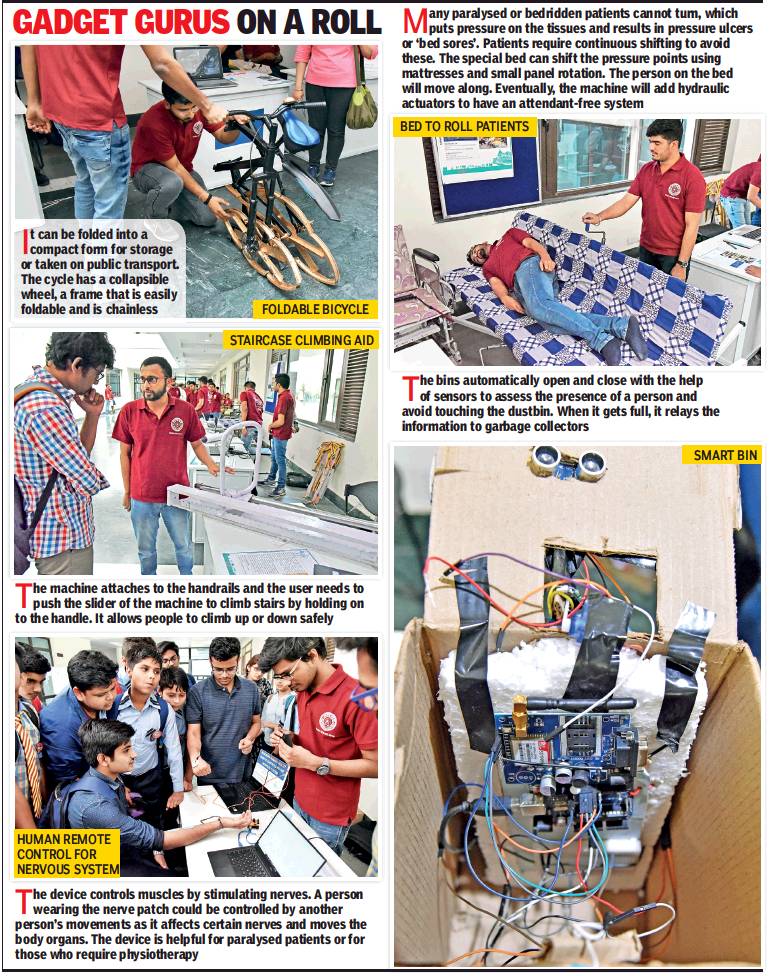
From: Mohammad Ibrar, April 21, 2019: The Times of India
Students of Indian Institute of Technology, Delhi, might have found a solution for patients suffering from loss of muscle movement or paralysis. The device made by them “hijacks the human will through remote control” allowing a person to control the muscles of another person through nerve control.
Along with a foldable chair, which is easy to be carried around, to a smart bin that sends signals when filled to its brim, IIT-Delhi students presented a mix of devices and innovations at its 15th Annual Open House on Saturday. Tapan Kumar Nayak, the group leader behind the nervous system control project, said the idea was to help patients suffering from neurological diseases and assist in their recovery. “The device transmits signals from one individual to the muscles of another individual and helps with their movement; thereby assisting paralysed patients,” the researcher at the Kusuma School of Biological Sciences at IIT-Delhi added.
Over 3,500 school students from across Delhi-NCR visited IIT Delhi on Saturday to witness the open house programme. They were seen gathering around a foldable bicycle — which was compact and could be carried around easily. According to Hemant Kumar, the MTech student behind the innovation, the compactness of the bicycle will assist people to carry them around hilly terrains or keep them parked in places where there is shortage of space by folding and unfolding them at will.
Most of the students were, however, mesmerised by the 3D printer developed by the IIT students and the tricks of magnetic levitation, holograms and the virtual reality headsets.
Vansh Rajput, a Class IX student of Andhra Education Society, who was visiting the IIT campus for the very first time, said he was encouraged by the devices and the innovation on display. “There are so many good things here. I liked the 3D printers and the robots built by the IIT students. Even I want to do something like this in the future,” he said.
There were over 60 demonstrations and over 300 posters on health, energy, clean air and water, artificial intelligence, robotics, and nanotechnology for them. The children were also shown a glass blowing lab and numerous robots. V Ramgopal Rao, director of the IIT-Delhi, said that in a campus like IIT, there are plenty of activities taking place. “It is a campus buzzing with activity day-in and day-out. It is important to expose children to some of these research activities early on. They may not understand everything, but they will have life long memories of what they see or hear during their day long interactions and visits to the research labs.”
[edit] 2019: innovative ideas
[edit] A
Sep 19, 2019: The Times of India

From: Sep 19, 2019: The Times of India
Come September 21, you can taste a “mock anda bhurji” or try on a “cheap” armour vest as IIT-Delhi showcases its research to mark the third annual industry day. Representatives from over 500 industrial units will converge on the campus, with this year’s edition also scheduled to have a research cafe session — to allow students to have industryspecific interactions — and a women-in-science session to encourage female students to take up science as a subject.
The event “seeks to promote the power of industry-academia collaboration, kindle ideas for cogent partnerships and showcase cutting-edge research by IIT-D researchers”. It will showcase more than 200 innovative product prototypes and posters by the researchers. The five themes for Industry Day 2019 are Clean Energy for Sustainable Economy and Environment, Sustainable Medical Technologies, Emerging Nano and Advanced Materials, Sustainable Environment and Make in India.
Anurag Rathore, dean of corporate relations, said the institute had earlier held a session where representatives from Finnish companies had interacted with the students. V Ramagopal Rao, director of IIT-D, said: “To become an economic powerhouse, we as a nation, need to work on our challenges and build on our strengths. AI-based innovation in healthcare, clean-energy solutions to propel sustainability and efficient waste management solutions will be at the forefront of the collaborations to deal with our current challenges. Industry-driven research will focus on creating jobs for our youth and achieve our ambition of a $5-trillion Indian economy.”
The institute gave a live demonstration of some of its research-based products, such as “scrambled eggs” made of moong dal, “which has the potential to address protein deficiency among a large populace that avoids consuming meat or eggs”, and a state-of-theart research work on personal body armour by its Joint Advanced Technology Centre.
The event will also highlight the role of two newly formed centres of excellence dedicated to the cause of sustainability.
[edit] B
Mohammad Ibrar , Sep 22, 2019: The Times of India
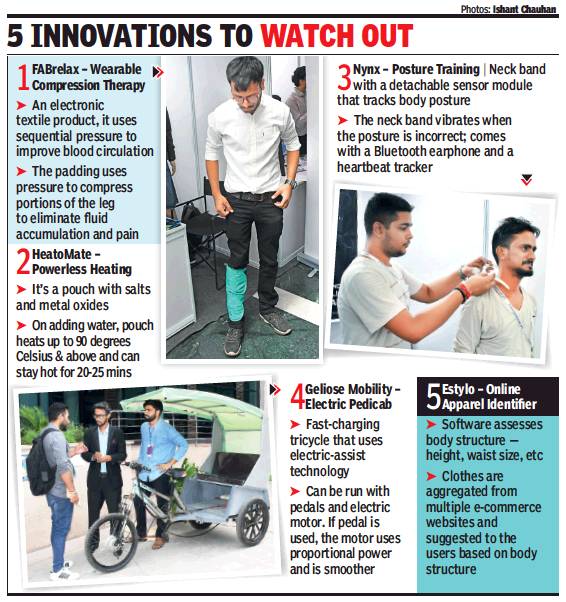
From: Mohammad Ibrar , Sep 22, 2019: The Times of India
A pouch of chemicals that doesn’t require power but can heat up enough to cook food, a neck band that helps correct your posture and tech-based clothing to aid blood circulation — these were some of the innovations on display at IITDelhi on Saturday, as part of its third industry day.
There were interactive sessions between industry experts and researchers, giving the students a chance to convert their innovative ideas into industry-ready products. This year, the five themes of the event were clean energy for sustainable economy and environment, sustainable medical technologies, sustainable environment, emerging nano and advanced materials and Make in India.
The speakers acknowledged the need to accelerate investment in an innovation-led economy to boost growth and develop a competitive advantage for India in the global market. VK Paul, member, NITI Aayog, was the chief guest. The inaugural session was attended by business leaders, members of the research community, delegates from Finland and Japan and the IIT-Delhi faculty.
Addressing the inaugural session, Paul said: “India’s progress is crucially dependent on the science we discover and understand, on technologies we can create and manufacture, and on products our people can use and access.” He gave an example of the medical devices market, which is currently worth $7-8 billion in India. “As much as 75% of this demand is met by imports. However, considering the talent and potential India has, this market can be worth $50 billion in India; and only innovation can achieve that,” he said.
Paul stressed on the idea of launching exchange programmes between medical institutions like AIIMS and IIT-Delhi on critical health issues, which can support immersion programmes of the latter.
The event saw a placement session organised exclusively for the institute’s PhD students — 17 companies interviewed more than 70 students.
V Ramgopal Rao, director, IIT-Delhi, called upon the industry to collaborate with the academia. “The role of the industry primarily was to develop products, and that of the academia to focus on education and research. But that’s changing now. The academia is expected to develop products through innovation.”
He said that IIT-Delhi was not only looking for collaborations with the industry, but also wanted the industry to treat them as a part of the innovation ecosystem.
Rao said that, soon, there would be more diploma and certificate programmes for the industry that could be pursued online from IITDelhi. “This will open up opportunities for private companies to collaborate with the research community.”
He thanked the government for expanding the scope of corporate spending under the CSR norms, “which will boost research funding in institutions like IIT-Delhi and promote collaborations between the academia and the industry”.
[edit] SC\ ST seats
[edit] 2016- 23
Shinjini Ghosh, March 17, 2023: The Times of India
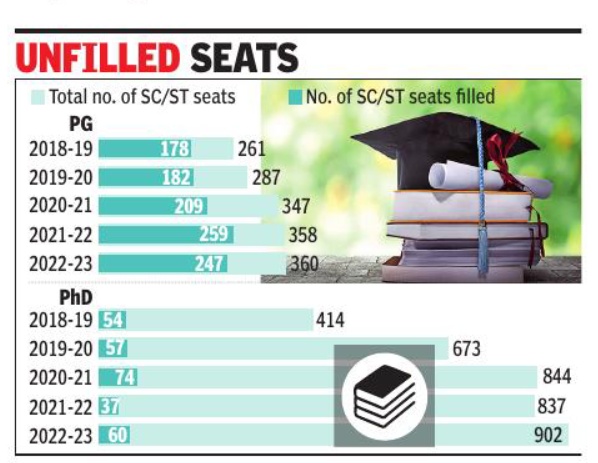
From: Shinjini Ghosh, March 17, 2023: The Times of India
New Delhi : While there is an increasing emphasis on research, especially with the implementation of the National Education Policy, participation of students from reserved categories in higher education continues to be skewed in premier institutions like Indian Institute of Technology (IIT) Delhi.
The information received in response to an RTI query filed by TOIrevealed that only 6% of the total number of SC and ST category seats for the PhD programmes were filled by the institute in the 2022-23 academic session. Out of the 589 SC seats and 313 ST seats, the institute admitted 50 students and 10 students, respectively, for the academic session. Similarly, in the 2021-22 academic session, out of a sanctioned strength of 543 SC seats, IIT Delhi admitted 32 students while against 294 ST seats, there were only five admissions.
In the past five years, the highest number of PhD admissions under the two categories took place in the 202021 academic session when 74 out of the 844 seats – around 8% – of the seats got filled. The scenario, however, is not the same for undergraduate programmes where not only were all seats filled, there were overadmissions as well in some of the academic years.
For instance, in 2021, out of a sanctioned strength of 182 for SC students, the institute admitted 187 students while in 2018, out of a total of 127 seats for the category, 137 students were enrolled for the various undergraduate programmes. Similarly, under the ST category, in 2022, there were 101 enrolments against 91 seats while in 2021, there were 93 enrolments against 91 seats under the category.
The corresponding data for the postgraduate programmes and subsequently for the PhD programmes reflect that with every progression towards higher education, the numbers have been reducing.
Representation of students from the ST category in the various postgraduate programmes is especiallyskewed with the percentage of seats filled in the past five years ranging between 50 and 60% with the lowest being in 2019-20 when only 37% of the seats were filled.
A former IIT director said that due to a growing trend of students opting for job opportunities post a BTech degree, it had been a challenge to fill seats in higher education at these institutes.
“With so many job opportunities present, not many are willing to pursue a PhD. For some reason, it has become a trend and a norm to take up jobs right after BTech, which is leading to this challenge. This is the case for the general category as well. With placement figures at a high, it is difficult to fill research seats with the leftover candidates,” the official said.
The former director added, “This reflects on faculty appointments too. In so many IITs, it is difficult to fill positions as good candidates with research background are few in number. Less than 5% of the students are going for higher education and it is definitely worrying. This was not the case earlier. ”
[edit] Women students
[edit] 2016-18
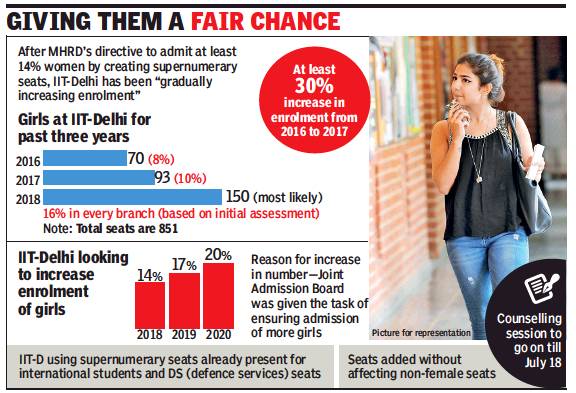
From: Mohammad Ibrar, IIT-Delhi tops MHRD mandate, enrols 16% girls in all its courses, July 5, 2018: The Times of India
Centre Has Asked All 23 IITs To Raise Enrolment Of Female Students To 14%
At a time when engineering institutes are struggling to admit girls, IITDelhi has touched an all-time high number of female students this year. The HRD ministry had mandated that all 23 IITs increase the enrolment of girls to 14% in 2018. While there are still another 15-odd days for the admission season to get over, IIT-Delhi has already recorded a 16% enrolment of girls in every course.
“Our faculty members conducted special interaction sessions with all JEE-qualified girl students and their parents both last year and this year to explain the prospects of studying at IIT,” said Aditya Mittal, professor and chairman of Joint Entrance Examination-Advanced at IIT-Delhi.
The sessions for two consecutive years are already showing results. In 2016, IIT-D admitted 70 girls, which increased by over 30% to 93 in 2017 and this year it is likely to reach 150 out of a total 851 seats.
The idea behind the initiative was to help qualified female candidates make their choices during the JEE/JoSAA (Joint Seat Allocation Authority) 2018 counselling process. “The session saw over 150 students attending it where not just faculty members, but even student mentors interacted with potential candidates,” Mittal said.
Asked why fewer girls enrol in IITs despite getting good ranks, Mittal attributed it to several factors. “Our IIT-Mandi director Timothy Gonsalves in his four-year research found that there are many girls who get good ranks in JEE Advance but don’t enrol in IITs. Several parents we interacted with had the perception that engineering sectors like mechanical and chemical are not viable for girl students. Many avoid IITs as they prefer institutes closer to their homes,” he added.
There were some parents who didn’t agree to send their daughters for specialised preparations as they would do for boys. “The central idea to bring in more girls was based on the IIT ethos that we don’t provide literacy but education. It is also because we revise curriculum frequently. While 40% of our curriculum is core, 60% are electives chosen by the students,” Mittal said.
“We at IIT-Delhi are vying for more than 14% girl students this year. We want to enrol 17% in 2019 and 20% in 2020. Eventually, we hope that these steps would be enough to encourage more girl students to join the institute,” said Mittal.
The chairman of the JEE counselling said that the increase in enrolment will not be radical but gradual. “We have limited space in hostels, laboratories and classrooms and this endeavour will not be affecting the seats already allotted for non-female students,” Mittal added.